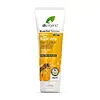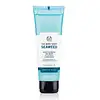What's inside
What's inside
 Key Ingredients
Key Ingredients

 Benefits
Benefits

 Concerns
Concerns

 Ingredients Side-by-side
Ingredients Side-by-side

Aloe Barbadensis Leaf Juice
Skin ConditioningWater
Skin ConditioningDicaprylyl Ether
EmollientPolyglyceryl-3 Methylglucose Distearate
EmulsifyingGlycerin
HumectantCaprylic/Capric Triglyceride
MaskingIsocetyl Palmitate
EmollientCetearyl Alcohol
EmollientMyristyl Myristate
EmollientOlea Europaea Oil Unsaponifiables
Skin ConditioningTheobroma Cacao Seed Butter
EmollientButyrospermum Parkii Butter
Skin ConditioningOlea Europaea Fruit Oil
MaskingGlyceryl Caprylate
EmollientTocopherol
AntioxidantHelianthus Annuus Seed Oil
EmollientMel
EmollientGlycyrrhetinic Acid
Skin ConditioningRetinyl Palmitate
Skin ConditioningXanthan Gum
EmulsifyingChondrus Crispus Extract
Skin ConditioningJuniperus Virginiana Oil
MaskingCitrus Medica Peel Oil
Pelargonium Graveolens Oil
MaskingPogostemon Cablin Leaf Oil
MaskingCitrus Aurantium Amara Leaf/Twig Oil
MaskingSantalum Album Oil
MaskingParfum
MaskingTrifolium Pratense Flower Extract
AstringentCalluna Vulgaris Flower Extract
Skin ConditioningRoyal Jelly Extract
Skin ConditioningSodium Benzoate
MaskingPotassium Sorbate
PreservativeSodium Phytate
Citric Acid
BufferingAscorbic Acid
AntioxidantLimonene
PerfumingGeraniol
PerfumingHydroxycitronellal
PerfumingLinalool
PerfumingCitronellol
PerfumingHexyl Cinnamal
PerfumingAloe Barbadensis Leaf Juice, Water, Dicaprylyl Ether, Polyglyceryl-3 Methylglucose Distearate, Glycerin, Caprylic/Capric Triglyceride, Isocetyl Palmitate, Cetearyl Alcohol, Myristyl Myristate, Olea Europaea Oil Unsaponifiables, Theobroma Cacao Seed Butter, Butyrospermum Parkii Butter, Olea Europaea Fruit Oil, Glyceryl Caprylate, Tocopherol, Helianthus Annuus Seed Oil, Mel, Glycyrrhetinic Acid, Retinyl Palmitate, Xanthan Gum, Chondrus Crispus Extract, Juniperus Virginiana Oil, Citrus Medica Peel Oil, Pelargonium Graveolens Oil, Pogostemon Cablin Leaf Oil, Citrus Aurantium Amara Leaf/Twig Oil, Santalum Album Oil, Parfum, Trifolium Pratense Flower Extract, Calluna Vulgaris Flower Extract, Royal Jelly Extract, Sodium Benzoate, Potassium Sorbate, Sodium Phytate, Citric Acid, Ascorbic Acid, Limonene, Geraniol, Hydroxycitronellal, Linalool, Citronellol, Hexyl Cinnamal
Water
Skin ConditioningSodium Laureth Sulfate
CleansingPolysorbate 20
EmulsifyingPEG-150 Distearate
EmulsifyingSodium Cocoamphoacetate
CleansingCocamidopropyl Betaine
CleansingPhenoxyethanol
PreservativeCitric Acid
BufferingSodium Benzoate
MaskingParfum
MaskingSodium Chloride
MaskingButylene Glycol
HumectantMenthol
MaskingTrisodium Ethylenediamine Disuccinate
Aloe Barbadensis Leaf Juice Powder
Skin ConditioningFucus Vesiculosus Extract
EmollientLinalool
PerfumingBenzyl Salicylate
PerfumingBenzyl Alcohol
PerfumingPropylene Glycol
HumectantSodium Hydroxide
BufferingChondrus Crispus Extract
Skin ConditioningWater, Sodium Laureth Sulfate, Polysorbate 20, PEG-150 Distearate, Sodium Cocoamphoacetate, Cocamidopropyl Betaine, Phenoxyethanol, Citric Acid, Sodium Benzoate, Parfum, Sodium Chloride, Butylene Glycol, Menthol, Trisodium Ethylenediamine Disuccinate, Aloe Barbadensis Leaf Juice Powder, Fucus Vesiculosus Extract, Linalool, Benzyl Salicylate, Benzyl Alcohol, Propylene Glycol, Sodium Hydroxide, Chondrus Crispus Extract
Ingredients Explained
These ingredients are found in both products.
Ingredients higher up in an ingredient list are typically present in a larger amount.
Chondrus Crispus Extract comes from a red algae native to the northern Atlantic coasts of Europe and North America. It helps hydrate the skin and is rich in antioxidants.
The antioxidants in chondrus crispus include lutein and zeaxanthin. Lutein has the ability to filter blue light from screens.
Other contents of chondrus crispus include polysaccharides, peptides, and amino acids. These help hydrate the skin.
What's the difference between algae and seaweed?
Algae is a broad term that includes seaweed. Not all algae is seaweed.
Citric Acid is an alpha hydroxy acid (AHA) naturally found in citrus fruits like oranges, lemons, and limes.
Like other AHAs, citric acid can exfoliate skin by breaking down the bonds that hold dead skin cells together. This helps reveal smoother and brighter skin underneath.
However, this exfoliating effect only happens at high concentrations (20%) which can be hard to find in cosmetic products.
Due to this, citric acid is usually included in small amounts as a pH adjuster. This helps keep products slightly more acidic and compatible with skin's natural pH.
In skincare formulas, citric acid can:
While it can provide some skin benefits, research shows lactic acid and glycolic acid are generally more effective and less irritating exfoliants.
Most citric acid used in skincare today is made by fermenting sugars (usually from molasses). This synthetic version is identical to the natural citrus form but easier to stabilize and use in formulations.
Read more about some other popular AHA's here:
Learn more about Citric AcidLinalool is a fragrance and helps add scent to products. It's derived from common plants such as cinnamon, mint, citrus, and lavender.
Like Limonene, this ingredient oxidizes when exposed to air. Oxidized linalool can cause allergies and skin sensitivity.
This ingredient has a scent that is floral, spicy tropical, and citrus-like.
Learn more about LinaloolParfum is a catch-all term for an ingredient or more that is used to give a scent to products.
Also called "fragrance", this ingredient can be a blend of hundreds of chemicals or plant oils. This means every product with "fragrance" or "parfum" in the ingredients list is a different mixture.
For instance, Habanolide is a proprietary trade name for a specific aroma chemical. When used as a fragrance ingredient in cosmetics, most aroma chemicals fall under the broad labeling category of “FRAGRANCE” or “PARFUM” according to EU and US regulations.
The term 'parfum' or 'fragrance' is not regulated in many countries. In many cases, it is up to the brand to define this term.
For instance, many brands choose to label themselves as "fragrance-free" because they are not using synthetic fragrances. However, their products may still contain ingredients such as essential oils that are considered a fragrance by INCI standards.
One example is Calendula flower extract. Calendula is an essential oil that still imparts a scent or 'fragrance'.
Depending on the blend, the ingredients in the mixture can cause allergies and sensitivities on the skin. Some ingredients that are known EU allergens include linalool and citronellol.
Parfum can also be used to mask or cover an unpleasant scent.
The bottom line is: not all fragrances/parfum/ingredients are created equally. If you are worried about fragrances, we recommend taking a closer look at an ingredient. And of course, we always recommend speaking with a professional.
Learn more about ParfumSodium Benzoate is a preservative. It's used in both cosmetic and food products to inhibit the growth of mold and bacteria. It is typically produced synthetically.
Both the US FDA and EU Health Committee have approved the use of sodium benzoate. In the US, levels of 0.1% (of the total product) are allowed.
Sodium benzoate works as a preservative by inhibiting the growth of bacteria inside of cells. It prevents the cell from fermenting a type of sugar using an enzyme called phosphofructokinase.
It is the salt of benzoic acid. Foods containing sodium benzoate include soda, salad dressings, condiments, fruit juices, wines, and snack foods.
Studies for using ascorbic acid and sodium benzoate in cosmetics are lacking, especially in skincare routines with multiple steps.
We always recommend speaking with a professional, such as a dermatologist, if you have any concerns.
Learn more about Sodium BenzoateWater. It's the most common cosmetic ingredient of all. You'll usually see it at the top of ingredient lists, meaning that it makes up the largest part of the product.
So why is it so popular? Water most often acts as a solvent - this means that it helps dissolve other ingredients into the formulation.
You'll also recognize water as that liquid we all need to stay alive. If you see this, drink a glass of water. Stay hydrated!
Learn more about Water